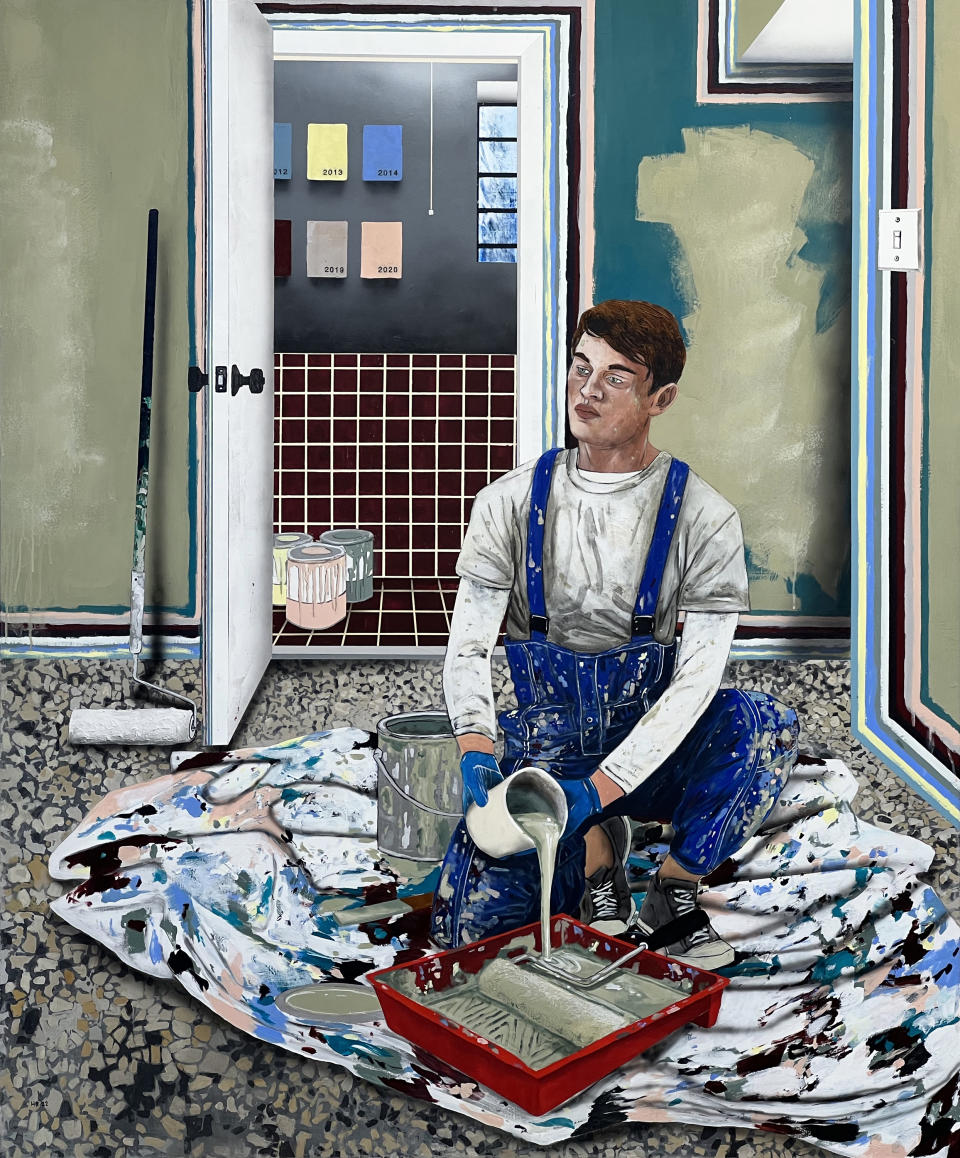Hernan Bas Brings His Conceptualists to The Bass Museum of Art
- Oops!Something went wrong.Please try again later.

“So the elephant in the room is that I’m doing a show in Miami during Art Basel Miami, which is one of the only times people ever come to Miami, to be honest,” says Hernan Bas.
It’s a few weeks before Art Basel, and the Miami-based artist is in the thick of installation for his new solo museum exhibition at The Bass Museum of Art on Miami Beach.
More from WWD
“The Conceptualists” presents Bas’ cohort of fictional artist peers, which he has spent the last few years painting and bringing to life from a running list of concepts. Showing them all together for the first time, Bas has decided to install the show in a configuration of mini booths within the museum, a reference that mirrors the physical space of the main Art Basel fair several blocks away.
“It’s the silhouette of an art fair, but subtle,” Bas says. “It feels like you’re walking into an art fair, even though it’s not actually the size of an art fair. When you’re walking around an art fair, for me it’s the aesthetic of looking down these long corridors and you have these little alcoves.”
The painter has been working on his “Conceptualists” series for more than two years, which evolved from several “one-off” paintings that Bas created for inclusion in group shows and fairs. Those first works snowballed into a series as Bas amassed a running list of ideas for other conceptual artists.
“Once the ball started rolling, as they say, I had to get through these lists. By the time the show opens, I’ll have made 39 actual paintings of these characters,” he says, adding that he has many more artist concepts that didn’t make the cut. “There’s some ideas that I love so much, but they’re just duds when it comes to making them into a painting,” he adds. “Because at the end of the day, I’m a painter.”
The series, however, allowed Bas to dip his brush into the language of conceptual art — and he found the process too fun to stop short.
“It allowed me so much leeway in making this, ‘Conceptualists,’ that I became obsessed with it — because I literally was able to make conceptual art under the cover of these other artists that I was portraying,” says Bas, adding that although conceptual art is “the easiest joke on the planet,” that’s not his intention. “I love conceptual art. I’m not making fun of it,” he adds, using one of the most well-known conceptual artists, Marina Abramović, as an example.
“It’s much easier to make fun of her than it is an abstract painting — because you don’t understand it, you know? So for me, it was so much fun to explore all these ideas about conceptual activities, practices — whatever you want to call it — and be able to pass it off to this other person,” he says. “Because if you don’t like what the artist is making in these paintings, or what they’re doing — it’s not my work, it’s their work. I’m just making a portrait of them,” he adds. “That became so liberating that maybe that’s why I’ve continued the series for as long as I have, because it opened a floodgate.”

The artists in Bas’ paintings are all fixated on idiosyncratic creative pursuits. In one, the artist is depicted crafting a casket out of his used Popsicle sticks; in another, the artist is in the process of repainting a room in the Pantone color of the year. Adding intention to the scenes, each painting is titled in two parts: “Conceptual artist #” followed by a parenthetical context for the image, and taps into the idea that the title of conceptual art is often more important to understanding the work than the visual.
“The figure themselves is the last thing I’m concerned about. It’s just a stand in,” he adds. “People concentrate so much on the fact that they’re attractive men in the paintings, and they completely forget that there’s something actually happening in the painting.”
A few examples: the Popsicle artist is “Conceptual artist #23 (Popsicle stick sculptor; a purist, he consumes his materials in devotion to his craft, leading to his inevitable last work).” Another artist, sitting on the floor in front of a store’s beverage refrigerator with a Polaroid camera and a selfie affixed to a milk carton, is “Conceptual artist #19 (A child of the ’80s, he places his Polaroid self-portraits in a familiar spot whenever he’s feeling lost).”
“I took advantage of those tropes within the language of conceptual art to play with titles and make sure that people can understand the work,” Bas says. “And that’s the other advantage of having the whole series shown in a museum, is that there’s labels next to every painting, whereas the last two groupings of this series have been galleries. There’s no labels in galleries.”
Bas notes that with the show opening, he’s excited to get to work on his next series, “which is a little more depressing, but exciting in its own way,” he says. The new works will be part of an upcoming gallery show in the spring, at Perrotin in Paris. The working concept is “lasts.”
“For example, the first painting I have planned for that series is ‘the last museum guard at the last museum on earth,’” he says. “When I mention the series to one or two people I talk to about art, they’re like ‘Oh, Hernan, are you done?’ It sounds so pessimistic, but the last — it’s just a concept,” Bas adds. “And I thought maybe the next series after that will be ‘the first.’”
“The Conceptualists” opens Dec. 4 and will be on view through early May.
Launch Gallery: Inside Hernan Bas: The Conceptualists at The Bass Museum in Miami Beach
Best of WWD

